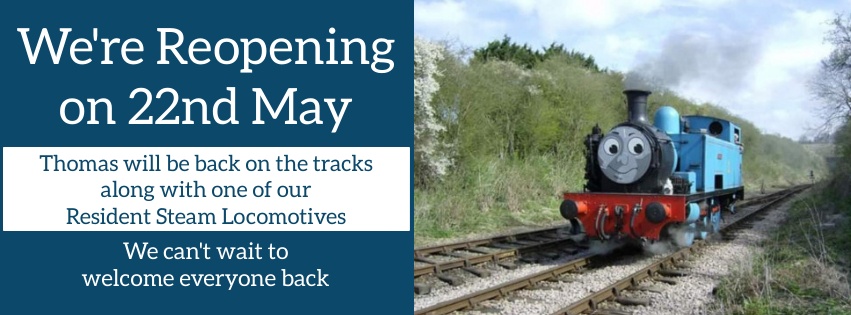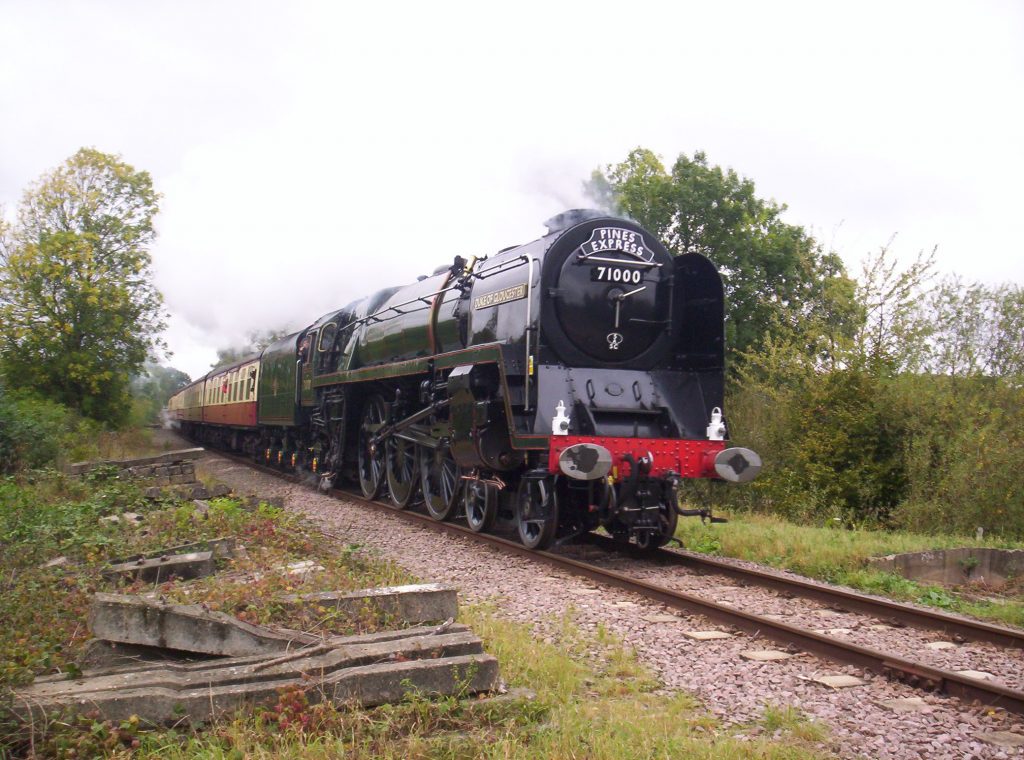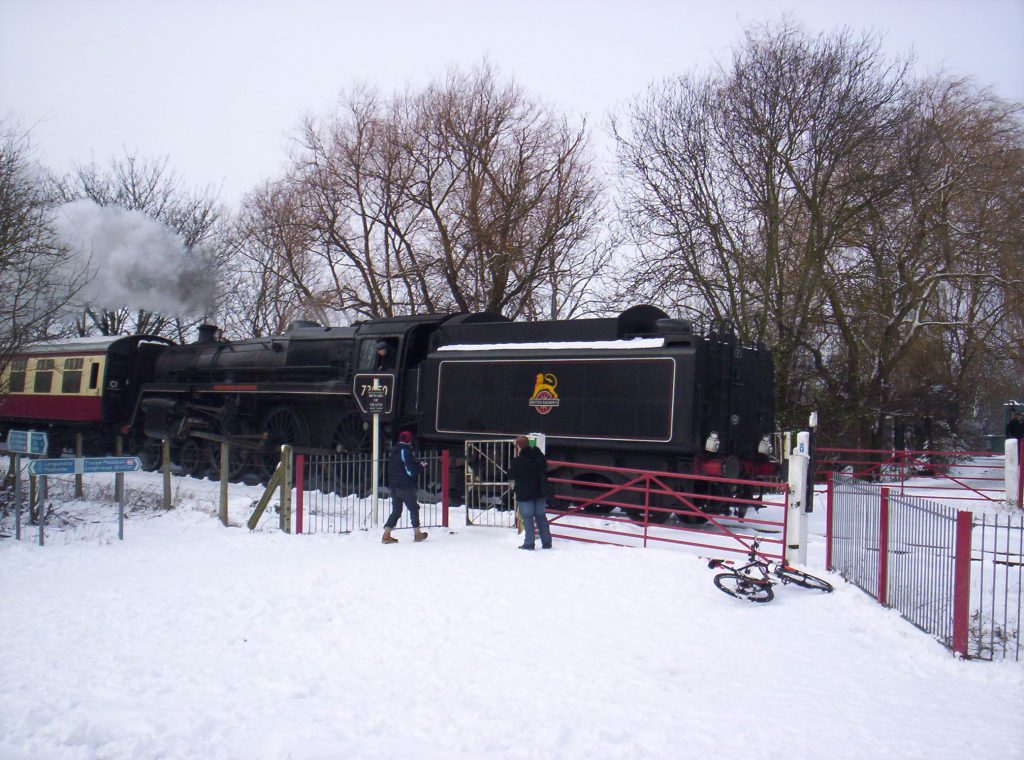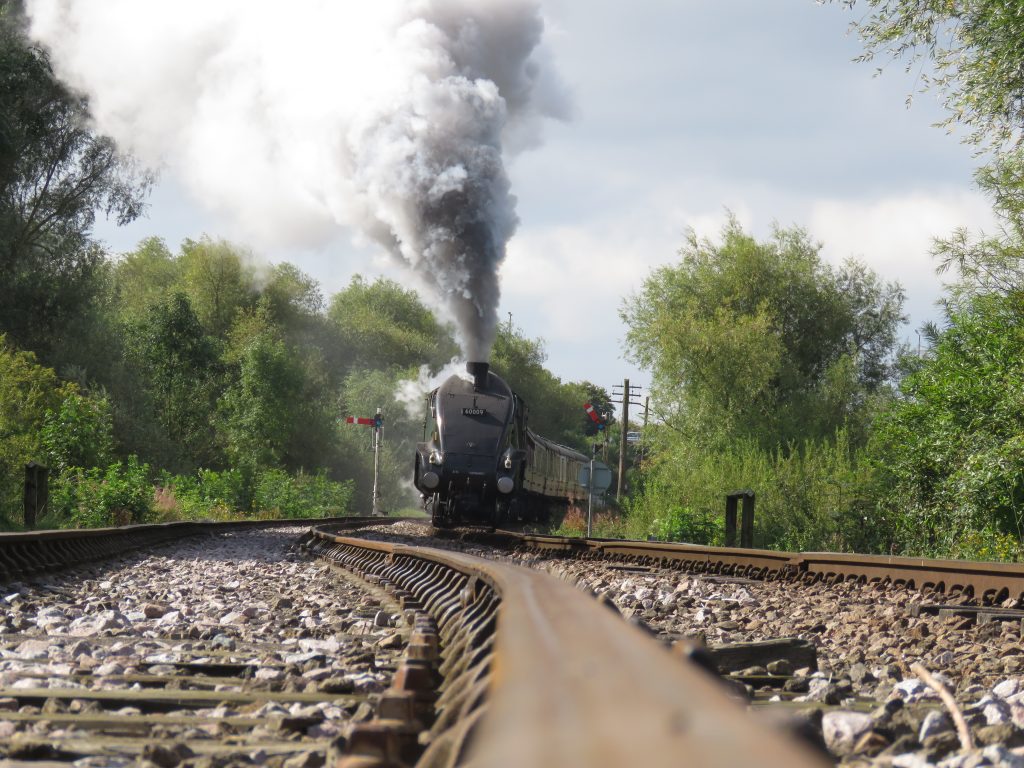
Excellent news, hopefully lots of tickets will be sold. Details are on the main Railway web site at www.nvr.org.uk

We are spending today preserving yesterday, so you can enjoy it tomorrow.

Excellent news, hopefully lots of tickets will be sold. Details are on the main Railway web site at www.nvr.org.uk
The other day I received an email, now that in itself is not unusual, I receive many emails every day.
But this one, just out of interest was from a member of the public not a member of the railway and asked the following question.
What is your most unusual memory?
Now that’s not an easy question to answer as I have so many memories of the funny, the sad and the unusual at the station I ran for over 14 years.
But one incident springs to mind and it is from the first year I was on the railway.
Now my first year was spent split between working at Ferry Meadows station and working on the trains as a TTI, and it is doing the latter job that this incident comes from:-
Highlight of the year without doubt was opening the compartment on the Mk1’s with the blinds drawn. On opening it I was greeted with the sight of a young lady on her knees in front of her boyfriend. She was topless. I said “Tickets please” she did not flinch, he almost went through the roof in shock, I clipped their tickets and left with the comment that I would not charge for the two bald headed children and shut the compartment door behind me.
Never a dull moment!!
For the first five years I wrote a short article covering each year.
These can be read on my old blog site at www.arkwrightsoforton.co.uk Should you read them I hope you enjoy them. Some of the information in them is no longer relevant but they do show my first five years on The Nene Valley Railway.

Go to main site at www.nvr.org.uk for details soon…
My thanks to Paul for this article, I hope you all enjoy reading it and learn something about the black stuff that helps power our steam locomotives.
By Paul Roe Locomotive Department Manager
Coal is very much in the news at the moment as the UK ceases to mine its own coal, some say we are facing a coal crisis and soon we won’t have any coal left and Heritage railways will soon struggle to operate. This is far from correct and coal is and will still be imported from other parts of the world, the ironic issue being the carbon footprint is much larger importing coal then actually mining it in the UK. Many years ago in the heyday of coal mining, people were scared that if mining continued the UK would float and float away
Coal is classified into four main types, or ranks: anthracite, bituminous, subbituminous, and lignite. The ranking depends on the types and amounts of carbon the coal contains and on the amount of heat energy the coal can produce. The United States holds the world’s biggest coal reserves. The nation’s proved coal reserves as of December 2018 stood at 250.2 billion tonnes (Bt) accounting for approximately 24% of the worlds proven coal reserves. Anthracite is found on the east coast in the US, South Africa, Australia, Western Canada, China and Russia. Two-thirds of Russia’s coal reserves are anthracite. Because of its efficiency and thus less carbon and sulphur usage per watt of power, anthracite is also the ‘cleanest’ coal in the world.
The NVR over the years have used coal from across the Globe, we have used Scottish, Welsh, Cumbrian, Russian, Polish, Bosnian. By far the cleanest is Welsh Steam coal, this coal provides high heat and less smoke, but is more expensive and takes a longer time to combust, so as a fireman you have to think about boiler management earlier than using a non-steam coal. At present a tonne of coal is averaging at £175 a tonne plus vat, coal consumption is different on each locomotive and several factors come in to play, size of boiler and firebox, how the driver operates the locomotive, the load that is being hauled, steam heat, is the coal of good source? So coal steams are terrible and the coal will just not burn hot. A locomotive the size of 92 Squadron would use up to about 1 tonne of coal per trip on the NVR, if the locomotive is running not stop less coal would be used and the locomotive would be working more efficiently. Currently the NVR is running on Scottish coal, this is a good coal but can be smoky coal, this can be controlled by the fireman, if you see dark thick black smoke, this would indicate that the fireman has over fired and not enough air is entering the firebox to burn the gasses away.
Composition of Air and Coal
Combustion takes place when coal burns in air, and correct combustion can only be obtained by bringing together the right amounts of coal and air at the same time. To examine this statement more fully it is necessary that we should know something of the chemical constituents of coal and air.
Coal varies in quality and composition, but the greater part of it consists of carbon, the remainder being composed of gases and ash (see Fig. 1).
Air consists of a mixture by weight of approximately 23% oxygen and 77% nitrogen, or when measured by volume, 21% oxygen and 79% nitrogen.


Coal comes in all different sizes and the ideal size of coal for burning on a steam locomotive is “The size of a man’s fist”, anything any bigger will take longer to burn and can make cold spots in the fire bed, we are currently in stock with coal on the NVR we about 35 tonnes of Scottish coal on site, this will soon be added to with about 28 tonnes of Northumberland coal which is being provided by West Coast Rail and a very good price. The Miniature Railway at Wansford operates on anthracite coal and these are the size of beans, anthracite is used on all steam models and it is smokeless so this stops the smaller boiler tubes furring up and creates a high temperature for the smaller fireboxes
One question that I have often been asked over the years, especially when it was raining was does the river flood very often?
The answer is yes it does on a regular basis and depending on the amount of rain the level of the river can change dramatically.
This year Nene Park was quoted as saying that it’s one of the worst winters yet for flooding.
Here are three pictures taken a few years ago at Orton Mere showing how the river can overflow and how close it can get to the station.



The above show the waters flooding immediately behind platform 2.
As a visitor said to me a few years ago. It makes a change from photographing trains.
The Fletton loop which is now part of the NVR was used for the deliveries of sugar beet into the British Sugar factory.
Here is a wagon label used for such deliveries.
The sidings are long gone.

Part Three – Overton to Peterborough Nene Valley.
In this final third chapter I will be showing you the popular spots to watch trains between Overton and Peterborough Nene Valley having covered Yarwell to Overton in Chapters 1 & 2. With a public footpath practically paralleling the whole railway all the way from Wansford to Peterborough there are plenty of good public places to view the railway from.
We start this chapter at the yacht club crossing just to east of Overton station situated on a curve it is a popular spot to see trains while out walking in the Ferry Meadows country park.
71000 Duke of Gloucester heads away from Ferry Meadows station as it was then called heading for Peterborough October 2011.

3F 47406 heads for Wansford October 2018

Orton Mere foot crossing and station are popular spots to watch trains especially on Gala days when the passing loop at the station is being used.
Prototype High Speed Train Class 41 on the trailing end of a class 56 as it heads for Wansford April 2016.

Double header combination Coal Tank 1054 & Pannier Tank 1501 exchange staff with the signalman as they depart Orton Mere for Wansford during the 2015 Steam Gala.

Deltic 55022 Royal Scots Grey passes 46100 Royal Scot which had just come off the main line.

73050 City of Peterborough arrives at Orton Mere in snowy conditions February 2012.

Class D306 Class 40 Atlantic Conveyor departs Orton Mere for Wansford during spring the 2010 Spring Diesel Gala.

Old friends reunite former Somerset & Dorset locos resident Standard 5 73050 City of Peterborough passes visiting 9F 92212 at Orton Mere station during the Steam Gala 2014.

Longville Junction along with Castor Bank one the two most popular spots on the railway to see trains going past its here where the fletton loop diverges off. Even though the 2 tracks are actually 2 single lines Longville Junction has got that main line look about it with double track.
D1062 Western Courier passes Longville Junction during the 2010 Autumn Diesel Gala, note how different the crossing use to look like before it was remodelled.

4464 Bittern passes Longville Junction with train for Peterborough during the 2012 Steam Gala.

Class 31452 passes by with a train for Peterborough during the 2016 Spring Diesel Gala.

Austreity 75008 Swiftsure passes Longville with a Santa Special for Peterborough November 2016.

60009 Union of South Africa opens up for a run past the junction during a photo charter September 2017.

One last good spot before we reach Peterborough the foot crossing at Wharf Road is always is good spot to see trains departing Peterborough especially if you are filming.
Large Prairie 4141 departs Peterborough for Wansford March 2013.

Lastly we reach the end of the line at Peterborough Nene Valley station.
4936 Kinlet Hall runs round at Peterborough during the 2011 Steam Gala.

A4 4464 Bittern is uncoupled at Peterborough during the 2012 Steam Gala.

Well that’s end of the three parts off photographing along the NVR I hope you have enjoyed reading them.
There is a lot to be learnt from old railway maps.
Take this one for example:-

If you look at this map you will be able to follow the line from Wansford to Peterborough and beyond.
The keen ones will notice the line from just outside Wansford to Stamford. Also you will notice this map predates the Fletton Loop.
It’s interesting to use something like Google Earth to follow the old lines that whilst on this map don’t exist anymore, the Stamford one being a good example.
Have a try and look at what you can see from current on line maps of what still survives.
Kick start our Locomotive Shed appeal with a once in a lifetime, Railwayman for a day prize draw. We need to raise over £4000 to wooden clad our metal container to protect and secure it and create a traditional looking Locomotive shed.
The winner will spend a day on the NVR
Take breakfast with our Steam Locomotive Crew and see the locomotive up and close in the yard.
Guided tour of the Locomotive sheds
Tour of the Wansford Signalbox
Take to the footplate for 15 miles of steam action on our duty steam locomotive
Tour of the miniature railway
Finish the day off with a full round trip in the carriages
Souvenir Certificate to remember your day.
To enter our prize draw make a contribution of £10 or more via the prize draw button below, you can enter as many times as you like. and or add further donations, Draw will take place on 31st March 2021. The winner will be contacted and a date arranged subject to Covid conditions, the winner must be 18 years of age or over.
To enter the Prize Draw click on the Prize Draw button below or make a donation via https://nvr.org.uk/product.php/205/
Today is New Years day and the start of the new year.
Many will be wondering what it will hold for the railway.
The answer is of course, nobody knows. I mean who on this day in 2020 would have been able to forecast how the year would turn out?
It was a year like no other for the railway, and the staff and working members/volunteers came through it.
Our sympathies must go to those who had to be made redundant, it was necessary to enable the railway to survive a very difficult period, they will be missed.
History will no doubt show that we owe a debt of gratitude to those on the railway both paid and volunteer who time after time went far beyond what was required or even expected to ensure that the trains we were able to run were as safe as they could be for the visitors and that the site was as safe as possible.
So please remember when things become more normal and you visit railway that your visit is only possible because of those people. The people who remained pleasant and smiling wether face to face or answering the telephone.
If you are a member of the public who travelled on either the Santas or other trains we were able to run. Thank you for your support of the railway, it is without exception appreciated and we look forward to welcoming you back in better times.